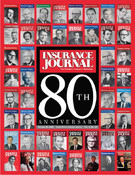Sharing 1,250 miles of border with Mexico makes Texas an inviting target for auto thieves, which is why 12 years ago the state legislature voted to slap a $1 surcharge on all auto insurance policies to fund the Texas Auto Theft Prevention Authority (TAPTA).
Since it was instituted in 1991, TAPTA has given out 406 grants totaling $149 million to fund local initiatives to prosecute auto thieves, beef up auto crimes police units and raise public awareness about how to protect against auto theft. Now, thanks to the state’s $9 billion budget deficit—and despite an impressive record of helping to reduce auto thefts in Texas by over 50 percent—TAPTA’s budget has been reduced by 34 percent to $10.4 million for the 2004-2005 fiscal year, according to a spokeswoman for the program.
“This is not at all a reflection on the effectiveness of our agency,” said Anna Mallett, TAPTA’s public affairs coordinator. “We felt it was very fair. It was a standard, across-the- board cut. Many agencies were dissolved altogether, and most others were cut around 30 percent, due to budgetary reasons.”
There are about 17 million registered vehicles in Texas, and although estimates vary as to how many are unisured that number roughly indicates how much money the state is collecting through the $1 surcharge and using for other purposes.
While TAPTA boasts of a 51 percent reduction in motor vehicle thefts since 1991—the agency did not begin distributing grants until 1993—the FBI’s Uniform Crime Reports show that auto thefts dropped by 26 percent across the country from 1991 to 2001. Property crimes of all types experienced a vast decrease nationally from 1992 to 2001. Robberies were down 37.1 percent and burglaries dropped by 29.2 percent.
In 1991, Texas’s rate of stolen vehicles per 100,000 registered vehicles was 1,175.8 and by 2001 it was down to 579.4. Mallett admits that the booming economy of the 1990s helped reduce the rate of auto thefts in Texas, and attributes the 0.1 percent increase in thefts to 102,943 in 2002 over the previous year to the jobless economic recovery.
“Basically in the last few years the reason we attribute to this increase is that this is an economic crime,” Mallett said. “The increase in population means an increase in the number of registered vehicles. Texas has 21 million residents now. This year we’ve had some funding cuts and we’ve lost a little bit, personnel-wise. We do the best we can but the economy really impacts this.”
The volume of thefts was higher because of increased population, according to a statement by TAPTA Board Chairman Mac Tristan, but “the rate of theft reduced to 482.2 vehicles stolen per 100,000 population. The rate of theft has not been this low since 1979.”
In a 1999 study for the National Center for Policy Analysis, a Dallas-based conservative think tank, economist Morgan Reynolds attributed Texas’ success in reducing crime to the steady rise in a criminal’s “expected punishment” in the Lone Star State.
“For every robbery committed, a criminal can expect to spend 217 days behind bars, up from 75 days in 1990,” Reynolds wrote. In 1990, criminals were spending less than 20 percent of their sentenced time in prison due to a shortage of space. By vastly increasing prison space in the 1990s, Reynolds claimed, Texas was able to provide a greater deterrent to criminals and outpace the national reduction in crime.
TAPTA funds five areas in its attempt to reduce auto thefts: law enforcement, prosecution, prevention (which includes recommending insurance discounts for certain anti-theft devices), reducing the sale of stolen parts, and media campaigns. If Reynolds is right, then directing millions of dollars toward law enforcement and prosecution efforts has paid off.
Law enforcement authorities were able to clear—or solve by arrest—15 percent of all reported auto thefts in 2002, 13 percent of which were committed by people under the age of 18. Seventy-five percent of stolen vehicles were recovered in 2002, according to TAPTA. Auto theft accounts for 10 percent of property crime in the state.
Almost 10,000 people were arrested for auto theft in 2002, a decrease of 0.6 percent compared with 2001. Eighty-four percent of those arrested were men, 66 percent were white, 34 percent were black and 28 percent were Hispanic. Most of those arrested were between 15 and 19 years of age.
The money distributed by TAPTA seems to be going where it is needed most. Five counties account for 73 percent of auto thefts: Bexar, Dallas, Harris, Tarrant and Travis. Houston has the highest rate of stolen vehicles, followed by Dallas, San Antonio and Austin.
Meanwhile, of the $14.7 million in grants awarded, $1.1 million went to Houston, $1.4 million went to San Antonio and about $1.1 million went o Tarrant County. El Paso, another auto-theft hot zone, hauled in nearly $1.2 million in TAPTA funds in 2002.
The Attorney General’s Office Auto Theft Strike Force was awarded $247,121 to assist with local prosecution efforts, but thanks to budget cuts, “as of 2004 it will no longer be around,” according to Mallett.
Still, TAPTA hopes to break even next year. “We understand we have cuts to deal with,” Mallett said. “But we hope to probably stay around the same [rate] next year.”
Was this article valuable?
Here are more articles you may enjoy.


 Progressive Q2 Net Income Skyrockets Over 320%
Progressive Q2 Net Income Skyrockets Over 320%  FM Global Rebrands As FM
FM Global Rebrands As FM  Beryl’s Remnants Spawned 4 Indiana Tornadoes, Including an EF-3: NWS
Beryl’s Remnants Spawned 4 Indiana Tornadoes, Including an EF-3: NWS  AIG Files Amended Suit Against Former Execs, Dellwood Insurance
AIG Files Amended Suit Against Former Execs, Dellwood Insurance 


